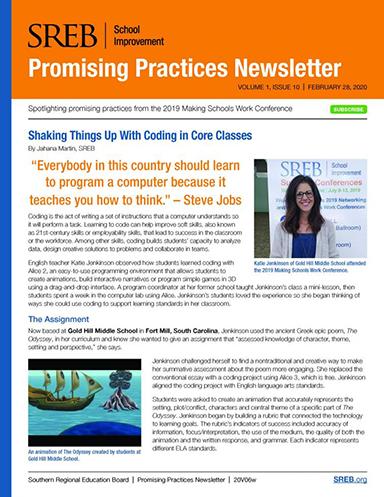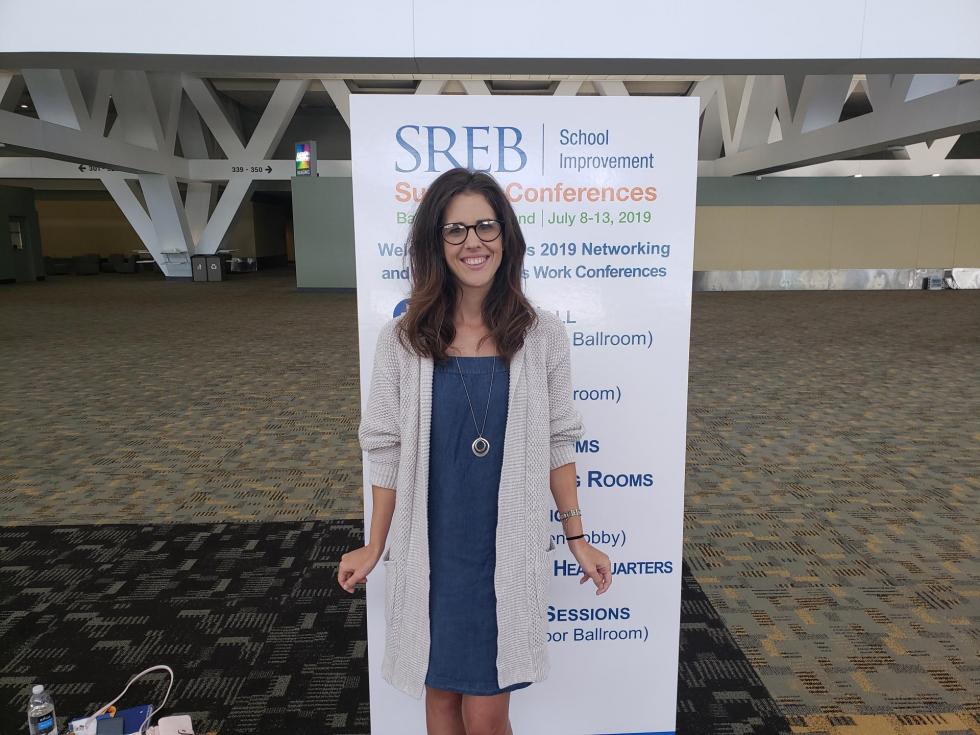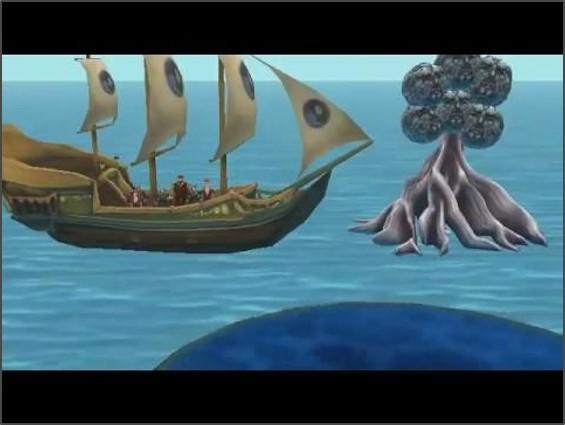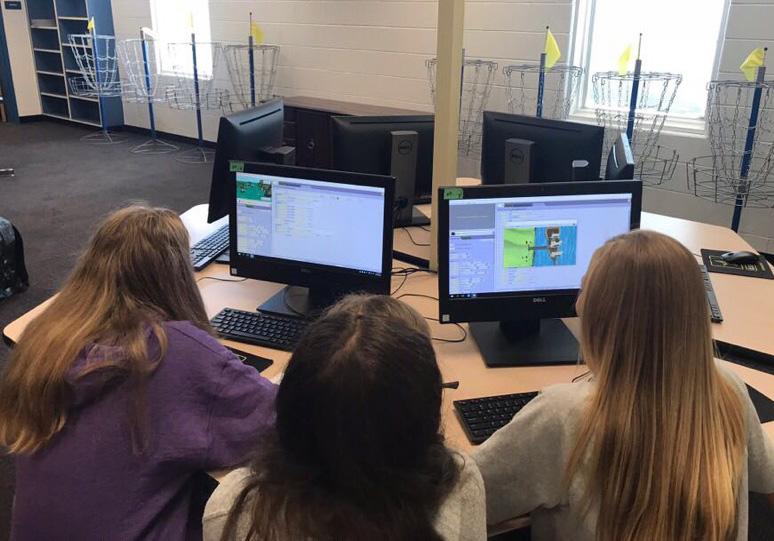Shaking Things Up With Coding in Core Classes
Promising Practices from the 2019 Making Schools Work Conference
 Coding is the act of writing a set
of instructions that a computer understands so it will perform a
task. Learning to code can help improve soft skills, also known
as 21st-century skills or employability skills, that lead to
success in the classroom or the workforce. Among other skills,
coding builds students’ capacity to analyze data, design
creative solutions to problems and collaborate in teams.
Coding is the act of writing a set
of instructions that a computer understands so it will perform a
task. Learning to code can help improve soft skills, also known
as 21st-century skills or employability skills, that lead to
success in the classroom or the workforce. Among other skills,
coding builds students’ capacity to analyze data, design
creative solutions to problems and collaborate in teams.
English teacher Katie Jenkinson observed how students learned coding with Alice 2, an easy-to-use programming environment that allows students to create animations, build interactive narratives or program simple games in 3D using a drag-and-drop interface. A program coordinator at her former school taught Jenkinson’s class a mini-lesson, then students spent a week in the computer lab using Alice. Jenkinson’s students loved the experience so she began thinking of ways she could use coding to support learning standards in her classroom.
The Assignment
Now based at Gold Hill Middle School in Fort Mill, South Carolina, Jenkinson used the ancient Greek epic poem, The Odyssey, in her curriculum and knew she wanted to give an assignment that “assessed knowledge of character, theme, setting and perspective,” she says.
 Jenkinson challenged herself to
find a nontraditional and creative way to make her summative
assessment about the poem more engaging. She replaced the
conventional essay with a coding project using Alice 3, which is
free. Jenkinson aligned the coding project with English language
arts standards.
Jenkinson challenged herself to
find a nontraditional and creative way to make her summative
assessment about the poem more engaging. She replaced the
conventional essay with a coding project using Alice 3, which is
free. Jenkinson aligned the coding project with English language
arts standards.
Students were asked to create an animation that accurately represents the setting, plot/conflict, characters and central theme of a specific part of The Odyssey. Jenkinson began by building a rubric that connected the technology to learning goals. The rubric’s indicators of success included accuracy of information, focus/interpretation, the use of the medium, the quality of both the animation and the written response, and grammar. Each indicator represents different ELA standards.
 The students’ task comprised
animation and written components. In the animation segment,
students were required to
The students’ task comprised
animation and written components. In the animation segment,
students were required to
illustrate the story’s central conflict, important characters,
primary setting and dialogue. For the writing component, they had
to write a statement of intent that outlined their rationale for
the animation they designed, explained the central theme of the
poem and described the heroic qualities displayed by Odysseus,
the poem’s protagonist.
“We do the animations, but they also have to tie everything together with what we did in class,” Jenkinson explains. “Within their story, they have to decide: Was Odysseus a hero? What qualities of a hero does he show? What do you think is the central theme or message in this story? They had to become experts in their story – and not just how do we show this to an audience, but also what do we want to show our audience about Odysseus as a man?”
“Everybody in this country should learn to program a computer because it teaches you how to think.” — Steve Jobs
Animating the Odyssey
Jenkinson divided students into groups and each group selected a different story within the epic to create their animation. There were eight available stories to choose from, such as the voyage from Troy or what happened on the island of the lotus-eaters. Once each group completed their animations, they pieced their animations together to make a final movie.
In addition to helping students demonstrate their knowledge in a content area, using Alice 3 pushes students to own their learning. Jenkinson advises her class to look at tutorials, search the Alice website and find other resources. “Students can and will problem-solve. [They] will make mistakes, and they will recover,” she says.
One of Jenkinson’s students says: “I think it’s great because we can teach kids how to program through language arts. These are skills they’re going to be using throughout their lives. So it’ll help them in the future; it’ll help them with their everyday lives because technology is the future.”
Especially gratifying is when a student takes the lead. “One of my students taught me how to use iMovie because I’d never used it before,” Jenkinson shares. The student subsequently wrote up the procedure for using iMovie for the class.
“I don’t know how she got the idea, but it made it more interactive and interesting to learn more things like programming and get more in-depth with The Odyssey and understand it more through the project,” another student remarks.
Collaboration Across the Board
“Collaborating among teachers is just as important as students
collaborating with each other,” states Jenkinson. Frank
DiMaria, a computer teacher at Gold Hill, helped Jenkinson’s
students with the more technical aspects of Alice, and Megan
Mongelli, a district technology integration specialist, helped
the groups combine their scenes to create the class movie. An
administrator
even provided the voice of Odysseus for a student group.
 Jenkinson continues, “Each group
was able to work through difficulties and solve problems on
their own—whether they were figuring out technology or how to
divide work equitably or deal with lost time due to weather
and field trips. They learned things that I would not be able to
provide in a more traditional setting.”
Jenkinson continues, “Each group
was able to work through difficulties and solve problems on
their own—whether they were figuring out technology or how to
divide work equitably or deal with lost time due to weather
and field trips. They learned things that I would not be able to
provide in a more traditional setting.”
“It was really fun. I learned a lot about teamwork and a lot about coding,” another student says.
Contact(s): Katie Jenkinson, jenkinsonm@fortmillschools.org

